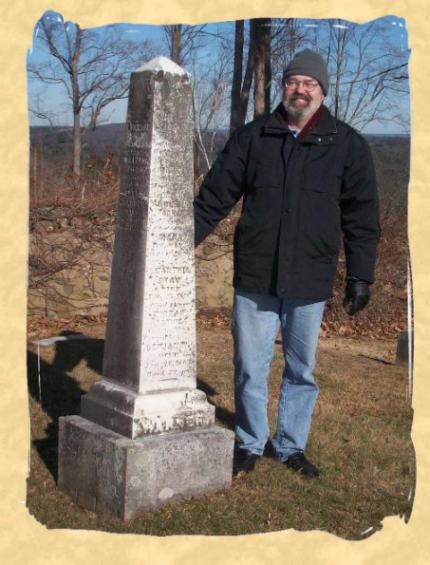
Alice: Lost and Found
The Location of Alice Watson’s Gravestone
“Are you still looking for Alice Watson? I found her stone in Connecticut.”
We nearly spilled our coffee as we read these words from Bill Warner, a Findagrave volunteer. It was the morning of May 4, 2013, more than six years after our last physical search for the lost Watson lot (EX895) in Exeter, Rhode Island, and three‐and‐a‐half years after writing up and posting that story.
Bill had found Alice Watson’s gravestone at Porter Cemetery in Thompson, CT – forty‐five miles to the north of where she likely was buried in 1855. After photographing headstones at Porter Cemetery for inclusion at Findagrave.com, Bill worked to cross‐reference them with the Hale Collection’s list of interments at Porter Cemetery. Alice’s name does not appear on that list. So Bill searched online to find mention of Alice Watson. He found our “Where’s Alice” web page right here. What Bill did next was a true Random Act of Genealogical Kindness: He went to the trouble of tracking back to our home page to find an email address, and then he wrote to us.
Bill, you are Our Hero, and we can't thank you enough! (That’s Bill standing next to a Warner monument in the photo on the right.)
We visited Porter Cemetery on June 12, 2013, with the help of John Rice, president of the East Thompson Cemetery Association.
Porter Cemetery is one of those old family burial grounds that now sits secluded in the woods: You practically have to walk through someone’s yard to reach the gates. John had gone to find Alice’s stone on his own, in anticipation of our visit. He guided us directly to where it lay, propped up in the northeast corner of the graveyard against a concrete post marking the corner of the Young lot. The nearest gravestone was that of Forrest E. Young.
Lichens covered the top three‐fourths of Alice’s stone. It was readable, but barely. Bill Warner’s photo of this gravestone shows a thin white line between the lichen‐encrusted top and a fairly dirty bottom. Torrential rains had preceded our trip to Thompson, apparently washing this dirt away. The stone obviously was broken, but all of the essential information inscribed on it was complete. When John picked up the stone to stand it in a more upright position, we saw behind it a shallow depression matching the shape of the bottom of the stone. John thought that whoever mowed the grass (fairly recently – the cemetery and its entrance were pretty well‐groomed) might have shifted its position.
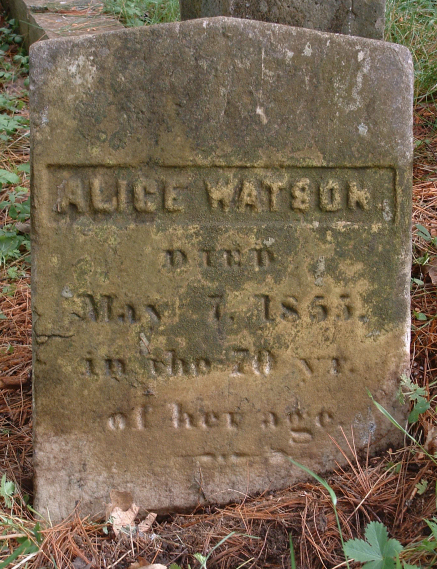
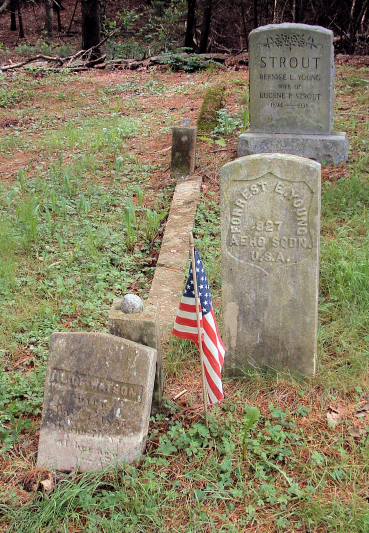
When dampening the stone with water did little to improve the clarity of its inscription, John used a soft‐bristled brush to remove a lot of the lichens. (John clearly has done this before and is aware of the fragility of old gravestones.) The difference was remarkable. This gravestone has to be the same one that was documented in Exeter, RI, by Charles and Martha Benns in the 1930s.
Why did Alice Watson’s gravestone leave Rhode Island? And where’s Alice?
When Bill Warner consulted our “Where’s Alice” article, he noted that Alice’s mother’s maiden name was Abiah Young. Since Bill found Alice’s stone propped up next to Young burials, he thought there might be a family connection that could explain the stone’s removal to Porter Cemetery. Our efforts to trace this Young family of Thompson, CT, turned up no link to Abiah’s family of origin. That’s not to say there is no link. It’s just that our search for earlier generations could not push past the 1860 federal census; and it stalled in Massachusetts, not in Abiah’s family’s native Rhode Island.
Alice’s other potential connection to Thompson involves later generations of Watsons who lived there and worked in the local mills. Was it possible one of them was responsible for transporting Alice’s stone? Again, we find no connection. Alice had been dead for a quarter of a century before her grand‐nephew Nehemiah Watson and his family took up residence in Thompson’s village of North Grosvenordale. And they didn’t hang around; these folks left well before 1900, most of them moving south to New London.
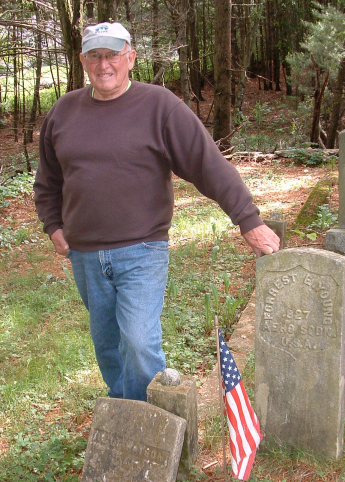
John Rice agreed with us that Alice’s stone appeared to be unassociated with any particular burial. That it ended up sitting next to Forrest Young’s gravesite may have been deliberate or completely random. Before we left Porter Cemetery, John placed Alice’s stone behind Forrest Young’s so it would be less exposed to lawnmowers and weed‐whackers.
Here's a picture of John. We really appreciate his kind and generous help!
When a grave is moved from one location to another, that generates paperwork. If Alice Watson’s remains had been transferred from Exeter, RI, to Thompson, CT, a transfer burial permit would have been issued and placed on file in the Town Hall. That’s where we went in search of documentation for Alice’s gravestone’s unexplained travels.
Jeffrey Barske, the Town Clerk, assisted us in looking for records pertaining to the Watson surname in general and Porter Cemetery burials in particular. Ultimately we came up empty‐handed, and Mr. Barske concurred: There was no scrap of paper or ledger entry to tell us when and why Alice Watson’s gravestone turned up in Porter Cemetery.
There are three “givens” in what we do know about this situation.
1. Alice died in 1855, and her burial was marked with an inscribed gravestone.
2. Charles and Martha Benns recorded the presence of Alice’s gravestone, and its data, in Exeter, RI, between 1931 and 1941.
3. The burials recorded in the Hale Collection listing for Porter Cemetery do not go beyond 1934. As we stated earlier, Alice’s name does not appear on the Porter Cemetery list. (The Hale Collection was created in Connecticut at roughly the same time Charles and Martha Benns were documenting gravestones in Rhode Island.)
What is the likelihood that Alice’s remains were exhumed from their original resting place and reinterred in Thompson? Not likely at all. Alice’s body probably was placed in a wooden casket that would have decomposed right along with Alice herself. Seventy‐five‐plus years later, when the Benns’ came by with their clipboards, the decomposition process would have been complete. There would be no ‘remains’ remaining. This is the primary reason why we doubt that Alice’s burial was reinterred elsewhere.
We think Alice’s gravestone migrated to Connecticut without Alice. Anyone who spends time in and around cemeteries knows that grave markers are prone to vandalism and relocation.
As we discussed in our original article (below this one), the “Lost Watson Lot” is quite likely in a section of the Arcadia Management Area in Exeter, RI. 100 Years of Rhode Island State Parks states that “during the [Second World] war, lands originally leased by the United States government for public works projects – Arcadia in Exeter, West Greenwich, Hopkinton and Richmond; Bowdish in Burrillville and Glocester; Carolina in Richmond; and Woody Hill in Westerly – became part of the state forestry program.” Ultimately, the RI State Parks & Recreation department took charge of Arcadia, which was largely left to become reforested.
If efforts were made to relocate individual gravesites or entire cemeteries from parkland areas, we are not aware of it.
We have hiked and driven a number of the dirt roads that criss‐cross the heavily‐wooded Arcadia Management Area – roads that once led to farms and residences. Along these roads, overgrown graveyards appear suddenly, noticeable mostly because they were lucky enough to be marked by stone wall enclosures. These plots have been left to the ravages of time, weather and encroaching plant life.
In the case of the tiny family cemetery where Alice Watson was buried more than 150 years ago, the same dereliction likely hid its location. If it had no stone wall enclosure, it would have been challenging to find even in the 1930s. Perhaps Martha and Charles Benns found this Watson lot with the help of someone who remembered where it was.
What likely happened to Alice Watson’s gravestone?
Gravestones have a habit of tilting, breaking, falling, and sinking into the ground, aided and abetted by freezing and thawing cycles. When we failed to find Alice’s gravestone in 2006 and 2007, we assumed it had fallen over and disappeared into layers of dirt, leaves, and pine needles. Now we think this stone was moved before we went looking for it.
Gravestones are heavy. Alice’s isn’t particularly big, but it’s not something you’d easily stuff into a backpack and tote out of the woods. More likely, Alice’s stone left the woods of Exeter with the mechanical advantage of a Jeep or all‐terrain vehicle.
The most likely scenario is that someone found Alice’s stone in the Arcadia Management Area and decided to take it home. A less likely scenario is that someone found Alice’s stone – which looked abandoned and alone – and tried to ‘preserve’ it by moving it out of the woods. If this were true, that preservation‐minded person would have sought to put it in the hands of the Exeter Historical Association or perhaps someone at town hall.
The author’s husband is skeptical of the idea that a person would remove a gravestone, only to put it in a cemetery unrelated to the burial. He thinks the stone‐snatcher wanted to use Alice’s gravestone as a coffee table.
We imagine a second act involving another person insisting that the gravestone be restored to its proper place. But finding the stone’s original setting out in the woods off Old Voluntown Road in Exeter would be impossible. The next‐best thing would be to deposit the gravestone in a cemetery, even if that cemetery were not the one where the stone belonged. Porter Cemetery, out in the woods but well‐marked and tended, is an ideal place to surreptitiously leave a loose gravestone. Whoever put it there has our gratitude. In Thompson, CT, this gravestone endures in memory of Alice Watson because someone loved her enough to have her name etched in stone. And someone else chose to treat her stone like the sacred object it is.
Anyone with better knowledge or information regarding the disposition of Alice Watson's gravestone is invited to write to the author. We would love to hear from you and would probably feature you in yet another incarnation of this article. You will find our email address on our home page. Thanks!
Below is our original article about the location of the Lost Watson Lot.
Where’s Alice?
The Location of the “Lost Watson Lot”
We’d have expected to find Alice Watson’s final resting place in West Greenwich, Rhode Island, the town her parents Samuel4 and Abiah (Young) Watson called home.
But Alice was buried in Exeter, the town immediately south of West Greenwich, in a tiny cemetery known as the “lost Watson lot.” Alice’s burial data was listed as follows on a (now‐defunct) page at The Rhode Island Historical Cemeteries Transcription Project website:
Last Name First Name (Maiden) Birth Death Cemetery#
WATSON ALICE 1786c ‐ 7 MAY 1855 EX895
The last people to locate this burial ground were Charles and Martha Benns, who documented hundreds of historical Rhode Island cemeteries during the 1930s. They described it as being on the “east side of [the] road, south of Tippecansett Park near Escoheag Hill Rd” in Exeter. There were four burials, only one of which had an inscribed stone – Alice’s.
While we have not quite succeeded in rediscovering the lost Watson lot, we do have an idea of where Alice might be. We think Alice Watson lies buried on the east side of Old Voluntown Road, north of the Congdon‐Hoxie lot (Exeter Historical Cemetery #1, aka EX001).
At first we were confused by the small map showing the location of the Congdon‐Hoxie cemetery in the book Exeter, Rhode Island, Historical Cemeteries, in which Tippecansett Pond is mislabeled as Breakheart Pond.[1] But our hunch that “Tippecansett Park” was really Tippecansett Pond brought us to Exeter Town Hall, with its plat map collection. And there we found not one but two little cemeteries drawn along the north‐south stretch of the dirt road extension of Old Voluntown Road.
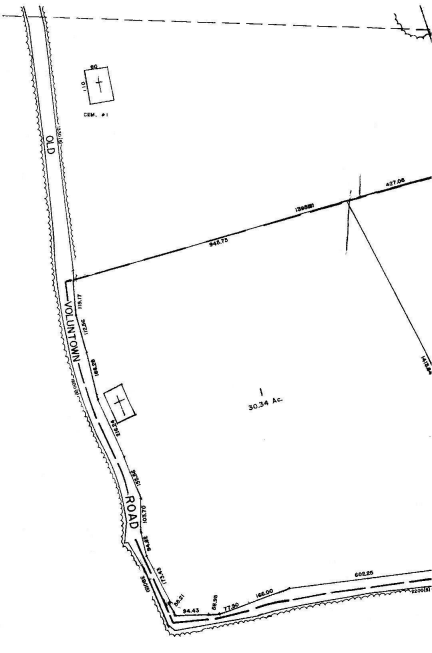
Exeter Plat Map #14 has distance markings on it, with a scale of ½ inch ≅ 100 feet. The scanned (and reduced) image shown here was made from a portion of that map as it was photocopied at Exeter (RI) town hall on November 9, 2006.
We were told on that occasion by an employee that the town of Exeter used Exeter, Rhode Island, Historical Cemeteries to identify and label the cemeteries appearing on its maps. This may have been done without confirming the measured distances: The cemetery to the north, labeled Cem #1, was drawn with measurement notations – 80 ft. by 110 ft. – appropriate to the stonewalled Congdon‐Hoxsie cemetery that appears shortly after the bend in Old Voluntown Road.
We obtained the following coordinates on November 9, 2006, using a hand‐held GPS:
Bend in Old Voluntown Rd. (where it changes direction from east/west to north/south) –
41° 35.121 N, ‐71° 46.89 W
Front gate at the Congdon‐Hoxsie cemetery –
41° 35.239 N, ‐71° 46.949 W
The Congdon‐Hoxsie cemetery is close to the road, and it occupies a high spot in the terrain. We visited to make sure the gravestones corresponded to the description given in the book.
Our coordinates, when plotted on a topographical map at the (now‐defunct) Maptech MapServer website, supported our suspicion that the plot to the south may in fact be EX001, the Congdon‐Hoxsie cemetery.
The northern cemetery along this stretch of Old Voluntown Road could well be the “lost Watson lot.” Our land evidence research points to Escoheag Hill in West Greenwich – within walking distance of Old Voluntown Road in Exeter – as the area where Alice’s father Samuel Watson lived and owned land.
This particular part of Exeter has been reclaimed by forest in the years since much of it was set aside as state park land. Maps showing the checkered areas of state park along Old Voluntown Road include a rectangular patch exactly where we estimate this northern cemetery to be.
We searched twice, once on Nov. 9, 2006, and again on March 30, 2007 – seasons during which foliage would be less obscuring. We did not find Alice Watson’s gravestone in this area as we had hoped, nor did we find any grouping of fieldstones resembling an old family graveyard. But if we’re correct about the location of this site, Alice lies peacefully in a place of natural beauty.
1 John E. Sterling and James E. Good, Exeter, Rhode Island, Historical Cemeteries (Baltimore, MD: Gateway Press, Inc., 1994); unpaginated.
Back to ALICE in the list of Samuel and Abiah Watson’s children.
Back to the beginning of the article “Regarding Samuel #26 Watson in The American Family of John Watson
of the Narragansett Country, Rhode Island”
© 2018‐2023 Elaine Schenot